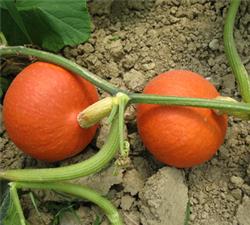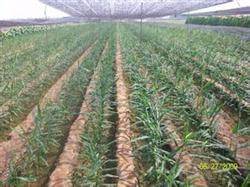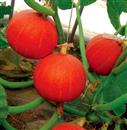New varieties of High quality Pumpkin and their cultivation techniques in Spring

The high-quality pumpkin varieties developed by the Horticulture Institute of Anhui Academy of Agricultural Sciences are partly bred by our institute and partly imported from abroad. Its common characteristics are: strong disease resistance, low temperature tolerance, weak light tolerance, easy fruit setting, easy cultivation, high yield, and the content of nutrients and health ingredients such as starch, pectin and vitamins is much higher than that of ordinary pumpkin, beautiful appearance, good commodity, good flavor and taste. Now some of the main varieties and cultivation techniques are introduced as follows. First, variety introduction 1, Ganli Wang: early-maturing hybrid generation, strong growth, strong stem, thick green leaf color, 6-8 nodes of the first female flower, continuous female flowers, good fruit setting, fruit development period of about 40 days. Single melon weighs about 2 kg, the fruit is flat and round, the pericarp is dark green, the fruit is neat and consistent, and the commodity rate is high. The meat is 3.2 cm thick, dense in meat, high in powder and good in flavor and taste. Resistant to low temperature and low light, anti-heat, anti-virus disease, wide adaptability. The average yield per mu is about 2000 kg. 2. Red chestnut king: early maturing hybrid generation, strong growth, stout stem, green leaves, 4-6 nodes of the first female flower, continuous appearance of female flowers, good fruit setting, fruit development period of 35-40 days. Single melon weighs about 1.5 kg, the fruit is flat and round, the pericarp is dark green, the fruit is neat and consistent, and the commodity rate is high. Meat thickness 3.0-3.2 cm, meat dense, high powder, good flavor and taste. Resistant to low temperature and low light, anti-virus disease, wide adaptability. The average yield per mu is about 1800-2000 kg. 2. Techniques of open field cultivation in spring 1. Sowing and seedling raising: the pumpkin varieties introduced above belong to the type of western pumpkin, and spring cultivation is suitable for early sowing, and the sowing date can be calculated according to the planting period. For example, between Jianghuai and Huaihe River, it can be planted in mid-late April, and the seedlings should be sown in mid-late March if the seedling age is 30 days. If it needs to be listed at a specific time, the sowing date can also be calculated according to the listing date. The seedling was raised by plastic film mulching in a nutrition bowl, and the bed soil could be mixed with 2 beat 3 soil, 1 stroke 3 mature organic fertilizer and 0.3% ternary compound fertilizer. The nursery bed nutrition bowl was arranged tightly and flat, and 1000 times of methyl topiramate was watered through the bed soil with warm water 1-2 days before sowing, covered with thin film. The seeds were fully dried before sowing, then soaked in 55 ℃ warm water, stirred continuously until cooled, and then soaked for 4-5 hours. Under the condition of 28-30 ℃, the seeds were accelerated to germinate for about 36 hours. After the seeds were exposed, the seeds could be sowed, one bud per bowl, the seeds were laid flat, the buds were facing down and the soil was 1-2 cm thick, and the top was covered with film and grass curtain to maintain a certain temperature and humidity. The optimum temperature for seedling emergence is 25-30 ℃. If the weather is good after sowing, the seedlings can emerge in 2-3 days. The optimum temperature in the seedling stage is 25 ℃ in daytime and 15 ℃ at night, keeping a certain temperature difference between day and night in order to cultivate strong seedlings. The seedlings were refined about 7 days before planting. 2. Soil preparation and fertilization. Pumpkin has developed root system and strong fertilizer absorption ability, so it should be ploughed deeply. The melon land should be ploughed once 15 days before planting, and 3000-4000 kg of rotten organic fertilizer should be applied evenly per mu. Open the box according to 2.5 meters (single row) or 4 meters (double row), make a planting bed 20-30 cm high, open a drainage ditch around, open a fertilizer ditch 40 cm away from the border ditch, apply 50 kg of potassium sulfate ternary compound fertilizer and 30 kg of calcium magnesium phosphate fertilizer per mu, and flatten the border surface after covering the soil. 5-7 days before planting, water can be fully irrigated and plastic film can be covered to increase the ground temperature. 3. Planting. Cultivated in the open field, planted when the seedlings grew to 2-3 true leaves and were free from frost. The cultivation density is different due to cultivation methods, pruning methods and varieties. The king of Chinese chestnut pumpkin has strong branching power, and double-vine pruning is mostly used. Single-row planting, climbing cultivation, plant spacing of 60 cm, about 550 plants per mu; double-row opposite climbing, one row on each side of the border, plant spacing 70-80 cm, 400-500 plants per mu. Erection cultivation, the width of the border is 2.5 cm, each border is planted in two rows, the plant spacing is 60-70 cm, 800 plants per mu. It is appropriate to choose sunny afternoon planting, nutrition bowl seedlings should be watered thoroughly before planting, in order to facilitate seedling shedding and prevent loose tuo from injuring roots, affecting the survival rate; after planting, it is necessary to irrigate the fixed root water once, and 20% quick killing is added to prevent underground pests. 4. Pruning and fruit setting. Generally, 7-10 days after planting, the main vine leaves 4-5 true leaves to pick the heart. When the vine grows to about 30 cm, two strong vines are selected, and the rest are all cut off. The remaining 2 vines are neatly arranged in the same direction to avoid overlap. The distance between the vines is generally maintained at about 30 cm, in order to fully receive the sun. If the vine is longer, the vine can be lifted back, part of it is around the edge of the planting hole, and the apex is still aligned, which is beneficial for the female flower to fully accept the sunlight during the blooming period, promote the female flower hypertrophy, and at the same time, it is easy to find the bearing site of the female flower to facilitate pollination. Pruning and branching should be done frequently before fruit setting, usually once every 5-7 days to prevent branches and leaves from growing too dense and prosperous. All pruning operations should not be carried out in rainy or dewy mornings to avoid germs invading from pruning wounds. The position of fruit setting node is related to plant growth and variety. Generally, the fruit is set at 12-25 knots, and it is appropriate for the 2-3 female flowers to set fruit on the vine. It is best to set fruit on 2 strips of vine at the same time, 2-4 on each vine. If the fruit-setting node position is too low, it is easy to produce malformed melons and small melons, low-node melons and deformed melons should be removed in time, leaving 3-4 good melons per plant. After each vine is polished, 5-8 segments can be left after the last one to promote fruit setting, or when the vine grows to about 30 nodes or has reached the next ridge, and all lateral branches can be removed. If the growth potential is weak, you can leave a vine without heart removal, or you can leave 1-2 sun vines after sitting on the fruit node, and all old and diseased leaves should be removed in the later stage to facilitate ventilation and light transmission. Male and female pumpkin flowers bloom earlier, usually bloom at 4 o'clock in the morning, but it is not easy to be fertilized after 9 o'clock, so it is better to pollinate at 5-8 am in the morning. When cultivated in the open field, the stigma and pollen are easily drenched by rain. The Corolla of the yellow female flower that will open in the morning of the previous day can be bound or bagged, and the male buds blooming on the second day will be collected and sprayed with water. The next morning, the Corolla will be bound or bagged after pollination to improve the effect of artificial pollination. 5. Fertilizer and water management. Because pumpkin has developed root system, strong fertilizer absorption and large amount of fertilizer, there can be no shortage of fertilizer and water, but the amount of base fertilizer, especially nitrogen fertilizer, should not be excessive in the early stage. Otherwise, it is easy to produce futile growth and affect fruit setting. Topdressing was carried out twice, and after the first pruning, a topdressing ditch was opened 50 cm away from the planting hole, 10 kg urea per mu, 15 kg potassium sulfate ternary compound fertilizer, combined with soil cultivation and weeding, if there was no precipitation in the vine extension period, it should be irrigated at the same time. After setting fruit for the second time, it is mainly available fertilizer, which can be applied with irrigation water, and the better soil moisture can also be applied in the middle of the border. 15kg compound fertilizer is applied per mu. In the later stage, 0.3% urea or potassium dihydrogen phosphate can be sprayed on the leaves to maintain plant growth and promote fruit expansion before melon harvest. In the middle and lower reaches of the Yangtze River, there are generally more Rain Water in spring and summer, and there is basically no need for irrigation during the whole period. in case of rainy season, it is also necessary to clear ditches and drain water to avoid diseases. Stop irrigation 15 days before harvest. 6. Pest control. When cultivated in spring, the main diseases are virus disease, powdery mildew, blight and downy mildew, and the main pests are yellow melon, aphids and small land tigers. The prevention and control of virus disease mainly lies in seed disinfection, preventing the spread of aphids, pulling out the diseased plants in time after the disease, and avoiding the spread of the disease. Powdery mildew and other diseases are mainly caused by high humidity. Therefore, it is necessary to give priority to prevention and combine prevention with prevention. Generally, high border cultivation should be adopted to reduce the field humidity, and 70% topiramate 1000 times solution, 75% mancozeb solution and other chemicals should be used alternately, generally spraying once every 7 days, in case of rainfall, it should be sprayed in time. Pests mainly harm pumpkin seedlings, and should be covered with plastic film in time after planting, and sprayed with trichlorfon, aphid lice, quick killing and other insecticides. In general, the seedling stage is sprayed every 3-5 days. 7. Harvest. The harvest of tender melons is usually 10-15 days after flowering, and the old mature melons are harvested about 40 days after flowering. When the chestnut king pumpkin is ripe, the pericarp changes from green to dark green, the pedicel is cracked, and the fruit is lignified. The first batch of harvested tender melons can be put on the market as soon as possible, and the second batch can be harvested after maturity and stored in a ventilated and dry place, which can be stored for 2-3 months.
- Prev

High-yield cultivation and Management techniques of Ginger in North China
First, prepare before sowing. 1. Fine soil preparation and application of sufficient base fertilizer. The plots with fertile soil, good irrigation conditions and no ginger blast should be selected to avoid repeated cropping as far as possible. On the basis of winter ploughing, fine soil preparation should be carried out as early as possible in spring, so that the soil can be loosened and fruited without light and dark. Increase the application of organic fertilizer, with high-quality chicken manure, no disease and disability.
- Next

Spring sowing and Seedling raising techniques of Western Pumpkin
1. Prepare seedling bowl (specification: 10 cm × 10 cm × 8 cm) and nutritious soil (50% mature organic fertilizer, 50% field sandy loam, mix well) before sowing. Before sowing, the seeds should be treated, the shrunken seeds and deformed seeds should be removed, the full seeds should be selected, and the seeds should be dried for 1 or 2 days in sunny days.
Related
- Where is it suitable to grow horseradish in China? it is expected to see the middle altitude horseradish in Alishan.
- How to prevent tomato virus disease reasonably? (Control methods included)
- Many people like to plant towel gourd on the balcony. What are the main points of this method and management?
- What crops can chili peppers be mixed with?
- Fertilization techniques and matters needing attention in Tomato
- What are the grafting techniques for peach seedlings in spring?
- Harm and control methods of root swelling disease of Chinese cabbage
- What are the pests of sweet potatoes? How to prevent and cure it?
- Symptoms, causes and Control methods of navel Rot in Tomato
- The cause of "Cucumber rotten bibcock" in Farmers' planting Cucumber and its Control Plan

